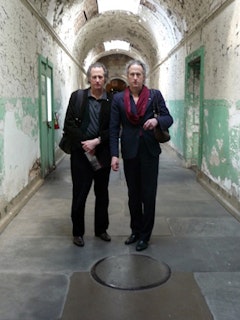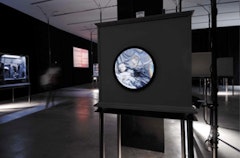ArtSeen
TRACKS: The Quay Brothers and the Argument for the Real
Perhaps the most salient point I can make about the art of the Quays is the sense of violation I feel by typing something—anything—onto the blank whiteness of the page.
What are their films about? That’s the implied question that an article like this is supposed to address, isn’t it? If not directly, then at least conjecturally: what can be said to help a curious viewer get a handle on a body of work that—as Michael Atkinson puts it in his catalogue essay for Dormitorium: An Exhibition of Film Décors by the Quay Brothers (now at the Kellen Gallery at Parsons)—is “as close to a purely subjective experience as modern cinema gets”?

A more germane question would be: is there another film, of any style, more sublimely melancholic than Rehearsals for Extinct Anatomies? More rapturously sinister than The Comb? More giddily perverse than This Unnameable Little Broom (aka The Epic of Gilgamesh)?
The shorts and features of the Quays play over the eyes and ears in a succession of stimuli that dart just beyond the reach of linear reasoning. Their enigmas and elisions provide fewer signposts for the moviegoer than a work of pure abstraction, such as Stan Brakhage’s hand-painted Dante Quartet, or a stream-of-consciousness dream-film like David Lynch’s Eraserhead, in which the opening sequence signals a sharp break from conventional storytelling. Encased within an artificial universe, a Quay Brothers film hints and feints at narrative resolution until it abruptly cuts you adrift—but with a lingering sense of haunted perfection.
A week before the opening of Dormitorium, I had the opportunity to speak with the artists on the phone from their studio in London. I was most curious about their perception of aesthetic control, or the lack thereof, in a medium as meticulously calibrated as stop-motion animation. Is there any room, I asked, for chance or spontaneity?
Their answer (as to be expected) was unexpected. They see the making of a film as “an arc of a series of accidents.” They storyboard nothing, blocking out the film in their heads. The tremendous amount of preparation they put into each production—designing and building the sets and puppets by hand (the painstaking detail of which is abundantly evident in Dormitorium)—is ultimately liberating. By the time they start shooting, they are so intimately familiar with the world they’ve created that they are completely open to the “discovery of the potential of the shots,” leading to unforeseen possibilities.
This is a far cry from the exercises in obsession that even friendly critics have deemed their films over the years. In fact, the word “accident” cropped up again in again in the conversation. The process of filming is “bumbling into an accident” or “laying traps for accidents,” where there’s always a “chance to find gaps” to fill with spontaneous ideas.
To create a precisely detailed, three-dimensional set in the age of green screens and computer-generated imagery might strike some as excessive or hopelessly quaint, but what matters most to the artists is physicality—to “get down on our hands and knees with a tape measure and move the camera a millimeter”—and the act of using their hands. For the Quays, touching is essential; they say that “hands think,” making their own decisions about the look and feel of an object before the eyes and brain have a chance to register.
Besides having “too much respect for the organic object” to employ CGI (of which they professed “a horror”), their main objection to using a computer is that it “couldn’t create the history” of the object. They imagine their characters as having lives beyond what is captured on camera, that the film has “caught one episode of the [character’s] journey.” By building and inhabiting a tactile domain, they are “lured into a metaphysical realm” that would be impossible to achieve if they were “shut in a closet with a computer and a mouse.”
With their perfectionist dedication to the real and the tactile, I would place the Quays in the same rank of radical modernity as Christoph Büchel, whose aborted installation, Training Ground for Democracy, at the Massachusetts Museum of Contemporary Art in North Adams was the greatest missed opportunity of the decade, and Song Dong, whose collection of detritus from his mother’s house, Waste Not, is currently filling the atrium of the Museum of Modern Art.
The brothers’ aesthetic shares with Büchel and Song a fascination with historical layering and the manipulation of a physical setting to provoke a visceral response. But instead of fabricating a human-scaled environment where visitors can wander and make their own associations, the Quays produce a world in miniature, often using found objects, which they explore through the fate of their characters. Such spontaneous object-based interactions, while expressed entirely in the language of cinema, set the Quays apart from other filmmakers—even Jan Svankmajer, the Czech surrealist with whom they are most often compared. For all of his innovation, Svankmajer’s animation is always at the service of a story; the Quays’ work is essentially visual, allusive, and emotional. (And it’s astonishing to consider how such literate and literary artists create the least literal of filmic works; it’s as if their respect for the power of the word puts them in a better position to engage it. Their adaptations of stories by Bruno Schulz and Robert Walser are not tied to the source material but run parallel to it. If Svankmajer's narrative impulse is manifest in his use of well-known and much-adapted texts by Lewis Carroll and Edgar Allan Poe, the Quay’s Street of Crocodiles and Institute Benjamenta are very likely the only versions that the audience is ever going to see; their lack of a narrative referent only reinforces their uniqueness as visual forms.)
Like many filmmakers, the brothers were immersed in visual art at the outset of their careers, studying photography and illustration at the Philadelphia College of Art (now called the University of the Arts, where Dormitorium originated). When I asked them if they considered the work in the exhibition to be art, they responded that it is “not precious” and that it shows the “artisanal side” of their process. The film is the final version, and the décor is “an intermediary thing…not artistic” but “a means to an end.” Even so, this exhibition, sensitively curated by Edward Waisnis, brings the Quays’ practice full circle, revisiting the confrontation with structure and surface that engendered the films and reasserting the primacy of the real.
As the artists told me during our conversation, “The way light falls is always beyond human control.” The element of chance and sense of wonder that light embodies—what it reveals and what it conceals—is at once mythic and mechanical, with intimations of Prometheus and Muybridge, who was the first animator, creating the illusion of motion from a sequence of individual photographs. And it is the catalytic act of lighting the set, flooding it with random visual cues, that fuels the Quays’ leap into the unknown.
It would be a mistake, however, to isolate the visual from the other elements in the Quays’ work, especially the musical score, which the brothers commission and receive before they start shooting. They regard it as the “dramaturgy” for the films, a paradoxical statement implying that an abstraction (instrumental music) is the source of their dramatic structure. This wouldn’t make sense in a narrative context, but in the films of the Quays, which they described in our conversation as “suggestive” and “imagistic,” it is a perfect marriage of forms.
The brothers themselves see their work as closely aligned with dance. When I brought up the use of the mask in Greek drama, relating it to the unchanging yet highly expressive faces of their puppets and dolls, they preferred to think in terms of ballet, and how “a dancer’s face remains the same but is transformed” through gesture and movement. (The Quays have designed productions of ballet, theater and opera, and have made several ballet films.)

This can’t help but bring to mind the twin pillars of contemporary dance, Pina Bausch and Merce Cunningham, who died within a month of each other this summer. Considered polar opposites, with Cunningham representing “pure” dance and Bausch resolutely impure, the surface arbitrariness of their work (Cunningham’s chance techniques and Bausch’s collaged tableaux) and its resistance to verbal articulation are of a piece with the Quays’ explorations of what a film can do.
As Maurice Merleau-Ponty wrote in his seminal 1945 essay, “Cézanne’s Doubt,” the expression of an artist looking at the world anew “cannot…be the translation of a clearly defined thought, since such clear thoughts are those that have already been said within ourselves or by others.” Still, we are suspicious of art that cannot be rationally explained, that greets the polyvalence of modern life not with analysis and compartmentalization but with jokes and riddles. Yet which is a more fitting embrace of a world whose infinite currents churn beyond the grasp of consciousness? Which is ultimately more real?
Discussing their décors and puppets, the artists spoke of a “density” that is both physical and metaphorical, and it is from this density—of material, of history, of culture and memory—that their images spring. They are not interested in dreams—in stark contradiction to everything that has been written about their work—but in “the in-between world,” the “fringe” between waking and sleeping—the “flickering” and the “liminal.” The state in which we are earthbound but free of physical laws, where the cocked head of a bluejay can dissolve into the feather-festooned skull of fluttering satyr. But the image and the source are as inextricably linked as the spark and the flint; again contrary to received opinion, the Quays’ fictions are not “hermetic,” enclosed entirely upon themselves—they do not slip reality’s bonds but pierce its manifold layers. They are both a refraction of the object and a dissection of its perception.
Merleau-Ponty writes, “The painter can do no more than construct an image; he must wait for this image to come to life for other people. When it does, the work of art will have united these separate lives; it will no longer exist in only one of them like a stubborn dream or a persistent delirium…it will dwell undivided in several minds, with a claim on every possible mind like a perennial acquisition.”
Through infinitesimal adjustments to their objects and décors, frozen into photographs and strung together by the persistence of vision, the Quay Brothers have lodged their indelible deliria into our collective imagination by dint of the truths they enfold. Like a Janus head, they simultaneously look back over the bloody century we have left behind, and forward to the
random strokes of fate swiftly descending upon us from a shallow depth of field.
Dormitorium: An Exhibition of Film Décors by the Quay Brothers continues at the Anna-Maria and Stephen Kellen Gallery of the Sheila C. Johnson Design Center at Parsons The New School for Design through October 4, 2009.
My thanks to Stephen and Timothy Quay, curator Edward Waisnis, and Kate McCormick of the the New School’s Department of Communications & External Affairs for their gracious assistance in the preparation of this article.




